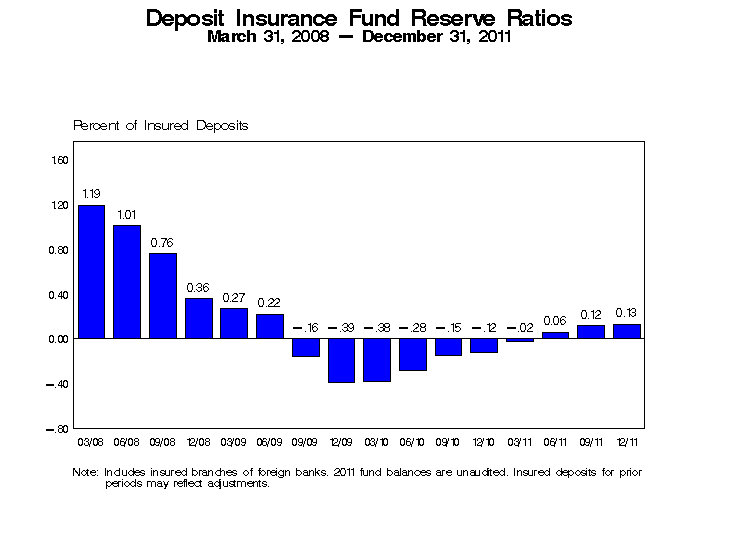The FDIC’s Quarterly Banking Profile for the fourth quarter of 2011 shows a modest but steady recovery in the banking industry. Despite the fact that a majority of banks reported improved quarterly earnings, 813 institutions remain on the Problem Bank List, comprising 11% of all FDIC insured banks and savings associations.
Highlights of the 2011 fourth quarter Quarterly Banking Profile
- The banking industry had full year 2011 net income of $119.5 billion, the highest earnings since 2006. The earnings recovery to levels seen prior to the financial crisis is impressive, considering the fundamental problems that the industry still faces going forward. Declining home values, record levels of home foreclosures, a sluggish economy and slow loan growth are likely to constrain banking industry earnings for years to come.
- Fourth quarter 2011 profits of the banking industry totaled $26.3 billion compared to $21.4 billion in the previous year’s comparable quarter. Although this is the 10th consecutive quarter of earnings increases, virtually all of the earnings increase was the result of lower provisions for loan losses, as has been the case for the past nine quarters.
- A significant number of banks are still struggling to become profitable, with 18.9% of all institutions reporting losses for the quarter, down from 27.1% in the previous year. Offsetting this weakness, 63% of banks reported an improvement in quarterly net from last year and return on assets (ROA) rose to 0.76% from 0.64%.
- Loss provisions for the fourth quarter totaled $19.5 billion, down by 40% from $32.7 billion in the comparable quarter of last year.
- Banks charged off $25.4 billion in uncollectible loans in the fourth quarter, down 40% from last year and loans and leases past due 90 days or more declined.
- One significant positive for the banking industry was growth in loan portfolios. Lending increased by $130.1 billion (1.8%) with an increase of $62.8 billion in commercial and industrial borrowing, an increase of $26.0 billion in residential loan balances and an increase in credit card lending of $21.3 billion.
- The flight to safety by nervous depositors continued with insured deposit growth of $249.7 billion, of which 77% was placed in non-interest bearing accounts which have unlimited deposit insurance coverage. The bulk of the deposit increases went to the nation’s 10 largest banks.
- The number of banks on the Problem Bank List declined by 3.6% to 813 from 844, the smallest number since the first quarter of 2010. Total assets of problem banks declined from $339 billion to $319 billion. A total of 18 banks failed during the fourth quarter of 2011 and 92 for the entire year.
 The Deposit Insurance Fund (DIF) increased modestly to $9.2 billion from $7.8 billion. The contingent loss reserve, which covers the expected cost of banking failures, declined to $6.5 billion from $7.2 billion. The DIF insures a total of $6.98 trillion in deposits resulting in a slim reserve ratio of 0.13%.
The Deposit Insurance Fund (DIF) increased modestly to $9.2 billion from $7.8 billion. The contingent loss reserve, which covers the expected cost of banking failures, declined to $6.5 billion from $7.2 billion. The DIF insures a total of $6.98 trillion in deposits resulting in a slim reserve ratio of 0.13%.
 FDIC Acting Chairman Martin J. Gruenberg gave an optimistic outlook for the banking industry going forward, saying that “2011 represented the second full year of improving performance by the banking system. Banks reported higher positive aggregate earnings, the numbers of ‘problem’ banks and failures declined, and loan balances increased in the final three quarters of the year. Insured institutions of all sizes continued to make substantial progress in improving their profitability.”
FDIC Acting Chairman Martin J. Gruenberg gave an optimistic outlook for the banking industry going forward, saying that “2011 represented the second full year of improving performance by the banking system. Banks reported higher positive aggregate earnings, the numbers of ‘problem’ banks and failures declined, and loan balances increased in the final three quarters of the year. Insured institutions of all sizes continued to make substantial progress in improving their profitability.”
It seems that the government is only concerned about the banks – but not the small businessmen who keep them alive….
It seems that the government is only concerned about the banks – but not the small businessmen who keep them alive…. Think about it. So if business fails, how will banks survive?
Exactly right. Small businesses have always been the backbone and driving force of the US economy.